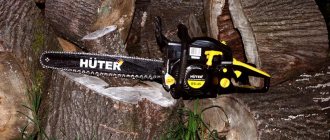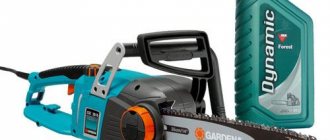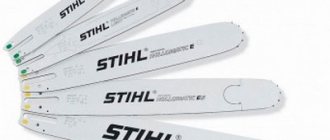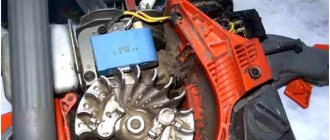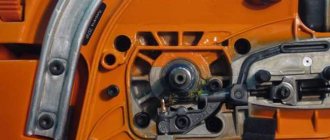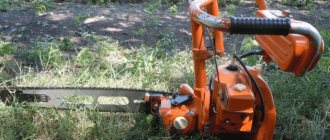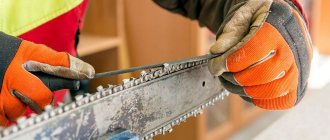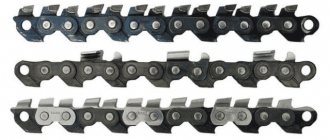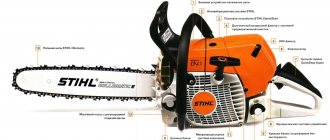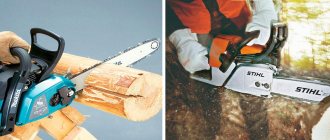How to lubricate the saw bar sprocket
The drive sprocket is an integral part of the chain saw drive system.
Drive sprockets, like chains, are divided into household and professional. If we consider the operation of a chainsaw in relation to the drive sprocket, then there are two correct options for operating the drive sprocket – saw chain pair.
Option one: one to one, use one chain until it wears to zero, after which, when installing a new chain, the drive sprocket also changes. This option is inconvenient because during intensive work it is difficult to monitor the condition of one circuit; it needs to be corrected in time, interrupting work and being distracted. If the chain has exhausted its service life very quickly (this depends on the number of nails cut), then you can install a new one and nothing bad will happen. But if the chain served faithfully for a decent amount of time and the owner avoided attacks on the nails, then the chain in this situation can wind several thousand kilometers along the tire. Here, replacing the star is necessary. What will happen if you don't change? Point one: a new chain on a worn sprocket is guaranteed to stretch after several revolutions. The second point is more critical: the pitch of the chain and the drive sprocket will be slightly different, the chain links will experience excessive load during operation, which can lead to a chain break. Users who use one circuit for a long time are rare, but they do exist.
Option two: two (three) to one. The use of two to three circuits with sequential alternation during operation. Alternating the chains is necessary for uniform wear of both all three chains and the drive sprocket. This option is more preferable, because it is economical and does not distract from work on straightening the chain.
Another feature of the operation of this part of the chainsaw is the maintenance of the drive sprocket bearing. The sprocket bearing only works at idle; when the throttle is open, the drum rotates at the same speed as the crankshaft and the bearing does not work. But the saw runs at idle for a certain amount of time and then the bearing comes into operation. The bearing needs to be slightly lubricated periodically. Lubricating the tire sprocket is suitable for this.
When the moment comes to change the drive sprocket and saw chains that have exhausted their service life, the sprocket bearing is also replaced. Usually for such cases a repair kit is sold for the drive sprocket and bearing in one package.
When choosing a drive sprocket, you must strictly follow the type of sprocket that you plan to replace or follow the manufacturer’s recommendations if the task is to modernize the saw. When replacing a drive sprocket with a pitch different from the one previously installed (the saw manufacturer must indicate such a replacement in the operating instructions), it is necessary to take into account the type of tire, because There is a driven sprocket on the tire. The driving and driven sprockets must have the same pitch, otherwise installation of the saw chain will be impossible.
Drive sprocket for Husqvarna 455e Rancher chainsaw.
Marking of the original Husqvarna sprocket for the Husqvarna 455e chainsaw. Catalog number: 537 29 17-02 (.325″x7 SPUR) . The sprocket is designed to work with chains with a pitch of 0.325″ and a shank thickness of both 1.3 and 1.5 mm.
The sprocket is manufactured as one piece with the clutch drum:
Bearing (catalog number 503 25 52-01 ) of the drive sprocket 537 29 17-02 :
Saw chain drive unit (clutch and drive sprocket) of the Husqvarna 455e Rancher chainsaw.
This small, inconspicuous part (drive sprocket) significantly affects the life of the saw chains and, in general, the operation of the saw system as a whole.
Source
1. The chain should fit tightly to the headset. There should be no sagging at the bottom.
2. The chain should move by hand along the bar.
Another point that, as a rule, users do not observe, but it is often described in the instructions for saws. In order to tension the chain, you need to lift the tire by the “nose”, tension the chain and fix the tire.
Are there ways to extend the life of an existing sprocket?
The main ways to extend the working life of a chainsaw drive sprocket:
- use several chains (preferably three). This method is the most gentle and convenient for the chainsaw owner in that there is no need to constantly tighten a chain worn out by intensive work. Operating three chains in turn will save the life of the sprocket and delay its replacement;
- high-quality maintenance of the drive sprocket bearing. This part plays an important role in the functioning of both the drive sprocket and the engine. For lubrication, it is recommended to use a special lubricant. The sprocket bearing is not constantly engaged, but only at idle speed, and therefore requires periodic lubrication. You can use a tire nose lubricant, such as standard lubricant from Repsol or Husqvarna.
The main signs that the sprocket needs to be changed:
- The chain on your chainsaw has been replaced twice (one of the current operating rules for chainsaws and electric saws is that if you use the tool frequently and actively, after two chain changes you should replace the drive sprocket);
- the quality of sawing deteriorated, the chain began to need tightening more often;
- you have installed a new chain to which the old drive sprocket (this part is not universal, and also has its own pitch, in addition, the pitches of the drive and driven chain sprockets must match, otherwise the tool will not work);
- you are using a different tire, shorter or longer.
READ How to Remove a Drive Sprocket on a Chainsaw
Running in the chain.
We start the saw, give medium speed and work at idle for 2 minutes (this is done so that the headset with the sprocket is lubricated and the chain warms up). After 2 minutes, turn off the engine and check the chain tension. If necessary, tighten if it is sagging.
Under no circumstances should you pull the chain into a hot state; before doing this, you must allow it to cool. Otherwise, the chain will inevitably stretch and will serve much less.
Remember! The chain must be cold when tensioning! When tensioning a heated chain, it is inevitable that it will be pulled out.
Lubrication of the sawing apparatus.
Getting started with a new chain.
During the first 30 minutes of work, observe the chain tension. If there is sagging, we stop the process. We wait until the chain cools down, and then tighten it and continue working again.
A dull chain leads to unnecessary stress both on itself and on the entire sawing unit as a whole. By applying extra effort, productivity automatically decreases and the load on the sawing machine increases.
The saw is intended for sawing wood only!
One tank of working mixture in saws is one working cycle.
Leading sprocket.
Directly affects the operation of the entire sawing machine!
The sprocket must be replaced if the wear depth is 0.5-0.6 mm.
Avoid excessive wear on the sprocket! This won't lead to anything good.
What will happen to the sawing apparatus if the sprocket is excessively worn?
The chain pitch will not match, the chain will automatically stretch. If the sprocket is extremely worn after pulling the chain, it may break. The RPM is extremely high, and you simply risk losing the new chain.
Bar or saw set.
The tire needs to be cleaned! Sawdust and oil accumulate in the tire groove. The lubrication hole on the tire needs to be cleaned! The lubrication hole is clogged - no lubrication! All this will lead to overheating and wear of the sawing apparatus.
Due to normal tire wear and tear, burrs may appear on the tire.
It is necessary to remove burrs from the tire with a file; if this is not done, the tire will wear out more intensively.
To ensure uniform wear on the tire rail, it must be turned over! The first day we work on one side, the second day on the other.
There is no need to accelerate by applying either high or low speeds, this can lead to burning of the clutch cup of the drive sprocket and the clutch itself.
You need to cut at a stable maximum speed!
Operating a chainsaw saw set
In the future, a saw set will be understood as a set of a drive sprocket, chain and bar. The saw set is the most worn part of any chainsaw. To extend its service life, you need to understand what affects its wear:
– during operation, the chain moves at enormous speed along the tire, driving and driven sprockets. That is, there is a movement of metal on metal;
– the chain does not move on its own. From one end of the tire it is moved by the driving sprocket, from the other end the driven sprocket changes its direction of movement to the opposite. That is, at the locations of the sprockets, both the chain and the sprockets experience additional load;
– different types of wood differ from each other in density. Denser wood is harder to cut. I won’t reveal a big secret - the load largely depends on how you cut along or across the wood fibers. Longitudinal sawing is harder than cross-cutting. That is, the wear of the headset is influenced by what type of wood you have to work with
– wood (just like people) is not perfect: it has knots, there is sand on the bark of the tree, and there are often nails. In a number of regions where fierce battles took place during the Great Patriotic War with the active use of all types of artillery, a lot of fragments are found in the wood. When processing such wood, sawmills often break, not to mention the chainsaw set. That is, any wood defects do not make the saw set healthy
Now that we know the villains who spoil our saw sets, we will give slightly detailed recommendations for combating them. Why expanded? – because every Russian who is not fully aware of some of the nuances is inclined to modernize the process. In simple words, the energy of our earth does not allow us to live according to the instructions (much less read them), and a chainsaw is a potentially dangerous tool and failure to follow the described regulations can threaten the life and health of the sawyer and those around him. There is no need to talk about wasted money in this context.
General regulations
– as we found out, in the saw set there is a movement of metal on metal. Therefore, lubrication is necessary wherever there is such movement. The most important thing is chain lubrication. It is carried out by a specially installed oil pump in the chainsaw, which supplies oil from a special tank to the chain. Your saw has two tanks: one for the fuel mixture and one for the chain oil. Now we are interested in the second one. It is advisable to use chain oil that is specially designed for this purpose. Any machine oil will do, BUT IT IS ABSOLUTELY IMPOSSIBLE TO USE USED MACHINE OIL . If you use it, you will break the oil pump. Spindle, transformer oil is also not the best option. During operation, the oil from the tank will decrease. Therefore, make sure that the oil tank does not run out of oil and there is no fuel in the fuel tank. Consider the viscosity of the oil and seasonal changes in this parameter. If the oil is too thin, it will be used up faster. Oil that is too thick may not be supplied to the chain in sufficient quantities. I'm not a professional sawyer. Therefore, I made it a rule to always pour less fuel than oil into the oil tank. The difference in level is about a finger. Yes, you have to refuel a little more often, but you also have to check the presence of chain oil more often. This works out cheaper than buying a new headset kit and oil pump.
– before starting work, make sure that the oil pump is working. It's simple: start the saw, give it maximum gas and bring the tip of the bar to a clean surface (without fanaticism). If oil is supplied, you will see oil droplets appear on the surface.
Read also: Routers, what are they?
– cleanliness is the key to long and trouble-free operation of the headset. Make it a rule to remove the brake cover after finishing work and clean the tool from dirt. The dirt is sticky and will not fall off on its own.
Preparing new chains, tires and drive sprockets for work.
– preparing a new chain for operation. It is not recommended to install and use the chain immediately after purchase. It is necessary to carry out preparatory measures. First, you need to place the chain in a solvent to wash off the process oil from it. Then you need to place the chain in a container with oil (you can use machine oil, BUT NOT WORK) and allow the chain to “soak”: so that the oil penetrates thoroughly into all the rivets. How to wash away process oil for a long time - most likely you have already done similar operations in another context. How long to soak - I do this: in the evening I put the chain in a jar with clean oil, and in the morning everything is ready.
– preparing a new tire for operation. In a new tire, the driven sprocket bearing must be lubricated. There is a special hole in the tire for this purpose. The bearing is “filled” with grease through it. Some tires (particularly some Stihl tire models) do not require pre-lubrication of the drive sprocket bearing. According to the manufacturer, it is lubricated during operation with oil brought with the chain. Therefore, you will not find a special hole for lubrication there. Lubrication is conveniently done through a special grease gun.
– preparing a new drive sprocket for work. Everything is a little simpler here. It is necessary to wash off the oil from the inside of the cup, as this part will engage with the clutch. The needle bearing must be lubricated. It will only work at idle speed of the saw. Therefore, it does not wear out as much as the driven sprocket bearing. It is convenient to lubricate the bearing using the same grease gun. It is advisable to lubricate this bearing regularly.
– after installing a new headset set, the chain, bar and sprocket will “grind in” to each other for some time. Therefore, control the chain tension.
Exploitation.
– the headset is used only as a set. Why? – The resource life of different components of the headset kit is different: the bus and the drive sprocket can easily outlive two chains. The question is how this will happen. Wear that occurs during operation leads to changes in the size and geometry of sprockets, bar grooves and leading chain elements. If these changes are within acceptable limits, then the instrument with this headset set works without problems. BUT, if you replace one of the elements of the kit with a new one, you will very quickly notice that it is out of order. For example, if you install a new chain on an old drive sprocket, it will most likely stretch out very quickly, and the drive links of the chain will quickly become unusable. It is clear why: due to deviations caused by wear, the rays of the sprocket differ from the parameters for which the chain is made. As a result of this discrepancy, the chain will become unusable. Therefore, if you read the owner's manual for your saw, you will most likely find the recommendation “one bar - one drive sprocket - two chains”.
– how to properly “ideally” operate a saw set:
– have and use two chains. Swap them periodically. Firstly, when one chain becomes dull, putting on the second one will not distract you from your work. You will edit a dull chain at another time. Secondly, and this is important, periodic change of chains will lead to uniform wear of all elements of the headset (especially both chains), more complete use of the resource embedded in them
– Turn the tire over periodically. This will ensure even wear of the tire grooves and rollers in the driven sprocket bearing. For the latter, this is more important: the rollers are cylindrical in shape. If the tire is not turned over for a long time, the rollers will wear out on only one side and will eventually take on a conical shape. Then there is backlash, premature destruction of the driven sprocket, unplanned expenses. By the way, over the past 10 years the quality of tires has decreased. While the quality of the tire itself remains the same, the quality of the driven sprocket has noticeably deteriorated.
– periodically lubricate the bearings of the drive and driven sprocket.
– over time, the chain may become dull and the cutting surfaces may become slightly deformed. You can straighten the chains with a special file and a mandrel that will set the correct sharpening angle. Make sure the cutting depth stop is at the correct height.
– make sure the chain tension is correct. An incorrectly tensioned chain (tightened or “loose”) - and you are guaranteed to make an unplanned purchase of a new saw set. Pay special attention to the chain tension when installing a new headset set: during the “grinding in” process, the chain will weaken. Pull up.
– two to three minutes after starting work, check the chain tension - during this time the chain will heat up, and when heated, the metal expands. Therefore, the chain will increase slightly in length. It must not be allowed to sag. After you finish the work, slightly loosen the chain tension: during the cooling process, the chain will shorten (this is also a phenomenon of thermal expansion of the metal) and the chain tension will increase. Storing a chain that is too tight will cause it to stretch. This will reduce the life of the chain.
– keep an eye on the chain lubrication. Check that there is oil in the tank and that the oil pump is operating correctly. Use suitable lubricants and NO OPERATION. No matter how much we talk about it, users still say all sorts of nasty things. Do not do that. If the saw is new and for this reason the oil pump fails, this is not a warranty case. Repairs are expensive.
What not to do
– DO NOT USE THE CHAIN LUBRICANT: the oil pump is guaranteed to break. If you want to try it, our online store is here
– Do not use the saw if the oil pump is faulty.
– You can’t sharpen the chain endlessly. Modern chains have a very thin hardened layer of metal. When sharpening, this layer is removed. Therefore, with each sharpening the chain will become dull faster and faster. On average, the chain is sharpened no more than two or three times. You can do more, but you pay for the consequences.
– straighten the chain only with an appropriate file and mandrel. If the chain is not correct, contact service. The chain will be sharpened on a machine. It is not expensive.
– if the chain is stretched, then I do not recommend shortening it by removing “extra” links. This is dangerous: during operation, the connecting elements of the chain have undergone deformation. No one guarantees that the chain will not break in the future.
– if the chain breaks, go to service. If possible, it is riveted there correctly. Refrain from doing this yourself - it is dangerous: without a special rivet machine, it is impossible to crimp the chain with the required force. An overtightened or, conversely, weakened rivet will cause the chain to break during operation.
– if the grooves in the tire are worn out and deformed so that the chain “walks” in it, which causes vibrations and beatings (this can manifest itself in the inability to get an even cut), then “tap” it, trying to return the grooves to their former shape and size , I strongly do not recommend it. It is impossible to do this. The consequences of such modernization can be disastrous.
– if for some reason the driven sprocket falls apart, just replace the tire, or preferably a set. Do not under any circumstances try to re-rivet the rivets on the sprocket. Don't add more work to surgeons.
– if the needle bearing of the drive sprocket fails, it is better to replace the sprocket and the bearing at the same time. They are sold only as a set.
- watch what you are sawing. Before work, visually assess the presence of foreign metal objects in the wood. A nail is a chain's worst enemy.
– if during the work your tire is “pinched” by the trunk, then you should not try to use the tire as a lever to lift the tree. You will only bend the tire. Release the jammed tire using other methods.
Read also: How to solder an smd LED
– sand is the enemy of everything moving. Once again, look at what you are sawing and how you are sawing. If the wood is heavily contaminated with sand, try to clean the cut area. While working, try not to “catch” the ground
– It is possible to cut ice with a chainsaw. But I don't recommend it. Once you have done this, then process the headset according to the regulations of the new set. People often jokingly ask: is it possible to cut concrete with a chainsaw? I answer quite seriously: yes, it is possible, but only with a special powerful saw with a special chain. A chainsaw for working with wood is not designed for this and will quickly fail.
– do not install tires larger than those provided by the manufacturer. The longer the bar, the greater the load on the saw. By exceeding the tire length allowed by the manufacturer, you are overloading the structure. This will make the saw break faster.
I want to use a TAD 17 chain on a Shtil 250 chainsaw. In winter it is very thick, won’t this make it worse for the oil pump, will it fail due to overload? And if possible, what is the principle of supplying oil to the chain in the pump?
The oil pump, which is installed at 180 - 250 Shtil, is generally practically indestructible - it has a brass cylinder. Even working off takes twice as long as aluminum ones.
And the principle of operation is very simple. It’s a pity, there is no illustration, and I haven’t seen it anywhere. In words – two parts, a cylinder and a plunger rotating in it. The plunger has a milled flat at the end. When rotating, the plunger moves slightly back and forth.
There are two holes made opposite each other in the cylinder. When the flat of the plunger approaches the intake hole, it is slightly pulled out of the cylinder - a vacuum is created and a little oil is sucked in.
When the flat is turned towards the discharge hole, the plunger is pushed into the cylinder - pressure is created, the oil flows through the channel to the tire. As you can see, in principle it is impossible to damage the pump with any amount of thick oil - it just won’t flow, that’s all. _____________________________________
If oil leaks from the tank when the chainsaw is idle, is this normal? Those. If you have to cut a little, then pour in a little? Otherwise, during the time the saw is inactive, the oil flows out of the tank completely.
No. It is not normal. The problem is either with the oil pump or with the reservoir itself. In general, oil and fuel consumption is usually 1 to 1. _____________________________________
How to lubricate the drive sprocket on a chainsaw? Is Mobil or JCB hydraulic lubricant suitable, for example? What do you think?
they smear the sprockets on all tires (except Shtilevsky ones), if you don’t smear them, the bearing can crumble, and then the tire is finished, and about Shtilevsky tires - on the one hand, this is kind of a plus, but on the other hand, I’ve seen almost new Shtilevsky tires with burnt-out bearings. _____________________________________
The chainsaw drives chain lubricant oil. At idle it flows very slowly, when you give it gas it flows in a stream. After about five minutes of operation, all the oil is poured out.
Does not respond to the position of the adjusting screw. Also, the sprocket that rotates the chain plays a little (0.5-1 mm). Who has encountered such a thing?
You need to remove the sprocket and reassemble the oil pump, and check the hoses for breaks. The drive sprocket must have a small amount of play. It shouldn’t be hard, vibrations will go to the crankshaft. _____________________________________
The holes match when I install it, maybe when tightening the chain the hole moves away because of this the oil does not get on the chain, but the chains, you can use one, how to dull, remove, put on a new one, sharpen the old one, etc. in a cycle of three chains do for now Is the tire worn out?
The oval hole for lubrication on the body of the chainsaw is made in such a way that at any position of the bar within the adjustment range of the chain tensioner, the alignment of the lubrication holes on the bar and the body does not disappear.
Ideally, a set of chains, when used on a saw one at a time in a cyclic mode, and the bar should become unusable at the same time. There are two lubrication options. Well, in the sense of what the oil is supplied through.
Most bars have a separate hole to supply lube to the chain, and these larger ones are used for tensioning. And some (and quite a few) do not have a separate lubrication hole.
And the free tension hole is used for lubrication. In this case, it will necessarily communicate with the groove of the tire. You can check with a wire. This is neither good nor bad, it is a feature.
So - in the second case, quite large oil losses are possible if the sprocket cover does not fit tightly. Then it just goes right through (unlike tires with a separate hole), and drips down. _____________________________________
After a minute of running the chainsaw at idle speed, I pressed the gas lightly several times and oil to lubricate the chain began to flow onto the chain so much that a puddle of oil formed right under the saw. Where is the chain oil adjustment screw located? And how to make this adjustment correctly?
Your model does not have adjustment of the oil supply to the chain; oil is supplied automatically. Carefully inspect and thoroughly clean the oil intake holes on the bar, carefully install the bar with the chain. In theory, it should help.
If a puddle of oil forms under the saw, then the most likely result is a sloppy tire or a clutch cover that is tightened askew, as a result, a gap appears between the outlet of the oil pump and the lubrication hole of the tire, into which the oil goes. _____________________________________
Tell us in more detail about the oil pumps installed in chainsaws.
Very rarely, modern chain saws (including electric ones) use non-piston pumps. One might say that they are not even applied at all. They all work according to the same scheme.
The main parts are an aluminum cylinder, rigidly fixed in the body and a steel plunger with a plastic gear, which rotates in this cylinder. How it works: There is one small hole at the blind end of the cylinder. There is another one opposite.
One of them is suction, the second is discharge. The plastic plunger gear has an oblique ring groove that aligns with a metal rod in the housing.
Mechanics: When the plunger rotates due to the oblique groove, it also performs reciprocating movements back and forth for each revolution.
Hydraulics: When the cut end of the plunger approaches the suction hole, the plunger is pulled back. A slight vacuum is created and a portion of oil is sucked into the cylinder.
Turn the plunger approximately half a turn - the cut section (with the oil in it, of course) approaches the discharge hole.
At this time, the plunger moves towards the blind end of the cylinder. Some pressure is created and the oil flows into the lubrication channel.
Now - about the differences in design: The gear on the plunger can be metal. In this case, the worm on the crankshaft will be plastic, there is no escape, there must be a weak spot.
The pump housing may be metal. Well, not bad, of course, but not essential. And the most important thing is adjusting the oil supply. In the first case, when the drive of the axial movement of the plunger is carried out by an oblique annular groove.
Adjusting the performance is technically not possible. If the longitudinal movement is carried out due to an oblique cut of the rear part of the plunger, it is possible to adjust the feed.
Using different options for the adjustable stop of the rear part of the plunger, the length of its axial movement changes, and, accordingly, the amount of oil captured per revolution of the plunger. _____________________________________
How often should you inject a chainsaw bar? And as I understand it, the lubricant should have a consistency similar to lithol? Or is the same transmission acceptable?
after 1-2 gas tank refills. In addition to special lubricants for the driven sprocket, you can use lithol or bearing lubricants of similar consistency, widely available in stores selling automobile parts and accessories. The transmission is too fluid for this. _____________________________________
Read also: What are fences for a private home made of?
I bought a new chain, installed it, works great. But after a couple of minutes, the hole in the oil supply bar becomes clogged and the chain runs dry.
Literally enough for one cut. I take it apart again, clean it, start it up. Without sawing, the chain is lubricated. And after one cut, the tire is again filled with shavings.
I didn’t try to throttle it because I didn’t have time, the chain almost jammed, I couldn’t turn it by hand, and the bar and chain were terribly hot, the chainsaw stalled. Tell me what the problem is, this was not the case with the old chain?
There is a big suspicion that in fact the oil is used for lubrication, only because of the large amount of dust (perhaps now you are sawing dry wood, or even with dust) that gets into the groove of the tire and is not visible on the chain.
What condition is the tire itself? Particularly important in this case is the condition of the driven sprocket and tire spacers (the chain slides along them during operation) in those places where the teeth of the sprocket “dive” into the tire during rotation or emerge from there.
Also, in case of excessive wear of the spacers, the depth of the bar groove could decrease below the permissible level and the chain shanks would cling to the bottom of the groove when moving.
In this case, there will also be excessive heating of the chain and bar. After all, apparently this chain is not the first for a tire.
In addition, the fact that the saw stalls when the chain jams indicates a failed clutch. There is either dirt between the clutch cams and the clutch cup, or the cup itself is deformed. The clutch springs may be stretched.
How to Lubricate the Chainsaw Tire Sprocket
You recently owned a chainsaw and still don't know what is the best oil to lubricate your chainsaw. Lack of this knowledge can negatively impact the tool, since the type and quality of lubrication depends on how long the tool's bar and chain will operate.
After reading this article, you will fill the knowledge gap as we look at the use of oils from different manufacturers and brands to reduce friction between the parts of the dust collector. And we will also understand what additional oils are used to maintain the chainsaw to extend its service life.
How to Lubricate the Sprocket on a Chainsaw Bar
Practical advice on hands
Chainsaw. a very useful thing in the house. In the end, it quickly and relatively easily solves many problems in housing construction, gardening and landscaping. Chainsaws. a rather capricious instrument, but with proper treatment it is an indispensable assistant. Who has one vulnerability: the guide. It bears the majority of the operational workload. And that means knowing why tires are more likely than other chainsaw parts to fail and how to properly replace them when necessary can help you save money and time with seasonal or project tools.
Chainsaw suspension
The tire and its fastening elements are considered consumables. Wear of this device occurs under load, as well as as a result of improper operation. You can immediately identify the presence of faults in this area. The tire will not be able to provide normal tension , lubrication and smooth running of the chain, and its fastening. fixing the saw axis relative to the tool body.
Proper lubrication of electric saws, chainsaws, or how to extend the life of the tire.
electric saw chainsaw
lubricate
the tire
properly.
How to maintain a chainsaw saw bar?
In this video you will find instructions for caring for a chainsaw saw bar.
Husqvarna. Several simple and at the same time
Fastening the saw blade
Do not use a saw with a faulty guide bar. Therefore, at the first sign of unit failure, you need to turn off the engine and find out what happened. Successfully eliminating the cause of the failure will help you learn about the design features of the bar and its attachment to your chainsaw.
The bar determines the axis and length of the saw, guiding the chain. But the basis of the mechanism is still the fastening. It is installed in a groove between the inner plate on the motor housing and the outer plate located on the chain set housing. The tire and body are secured with a bolted connection. This part of the mount is called the “motor assembly,” and its shape and design vary depending on the model of chainsaw. Tire holder and separate cover.
Studs for fastening tires
The drive links of the saw chain are mounted in a guide groove on the edge of the bar and engage with a drive sprocket connected to the power take-off shaft. When the locking bolts are loosened, the tire can move. adjust manually or, as on professional chain saws, automatically. Finally, there is a stop at the front of the tire mount. It serves to securely secure the saw axis when the moving chain comes into contact with wood.
Video: How to Lubricate the Chainsaw Tire Sprocket
But the fact is that the manufacturers recommend it, and it cannot be hidden. So, go back to the manufacturers and start with the popular brand Calm.
Stihl adhesive oils
The following adhesive oils are listed on the company's website for various operating temperatures and have good lubricity:
HUSQVARNA oils
The company offers its customers Husqvarna Bio Advanced oil for use in normal and extreme conditions. The oil is made from plant components and is environmentally friendly, supplied in liter and five liter containers.
As a cost-effective solution, Vegoil has an oil that, according to the manufacturer, reduces consumption by 40% compared to others. Supplied in liter containers.
The company also makes a bearing lubricant that recommends lubricating the drive sprocket and sprocket bearings.
Less common, but popular among chainsaw owners are:
You can become familiar with some chain oils by watching the video below, in which a salesman for a large chain of tools commented on the use of adhesive oils from various manufacturers.
How to replace the original expensive oil and is it worth it?
In cases where the original cannot be used, you can replace it with motor oil. Cheap automotive oils, such as automobile or diesel lubricants, are not suitable for long-term use due to reduced adhesive properties.
Some owners, despite the recommendations, still use analogues, preferring to change the bar and chain more often, but everyone must decide. Such oil cannot have a negative effect on the lubrication system, which means that the difference is only in protecting the tire from chain friction.
A little about lubrication of chainsaw chains
Cleaning is called oil that has entered the car's engine or transmission. Many chainsaw owners, when trying to save money, use them to lubricate the chain, which means serious repair costs.
The cause of these breakdowns is the presence of metal shavings during extraction of impurities, which settle in the crankcase, and also during drainage, the drain pan is removed from it.
When metal shavings fall on the tire, they act as an abrasive on its surface. Simply put, instead of protecting the surface, production increases wear on the tire, drive sprocket and tire bearing. Training also affects the chainsaw chain where it bends and increases the risk of the chain mechanism breaking.
Conclusion: to lubricate chainsaw chains, you must use original oils from the manufacturers. Engine starting is prohibited. In the absence of high-quality oils, a short-term replacement of pure automobile oils is allowed.
Source
Advantages of higher class oil pumps
The maintainability of dismountable pumps is sufficient to restore the operation of the unit at home.
The pump drive gears of budget chainsaws are mostly polymer. Advanced in terms of technical equipment, proprietary models with adjustable performance are equipped with drive mechanisms made of non-ferrous metals. The cost of such systems is compensated by economical, up to 50%, consumption of working fluid.
The main signs that the sprocket needs to be changed:
- The chain on your chainsaw has been replaced twice (one of the current operating rules for chainsaws and electric saws is that if you use the tool frequently and actively, after two chain changes you should replace the drive sprocket);
- the quality of sawing deteriorated, the chain began to need tightening more often;
- you have installed a new chain to which the old drive sprocket (this part is not universal, and also has its own pitch, in addition, the pitches of the drive and driven chain sprockets must match, otherwise the tool will not work);
- you are using a different tire, shorter or longer.
READ Replacing the Drive Sprocket on a Husqvarna Chainsaw

